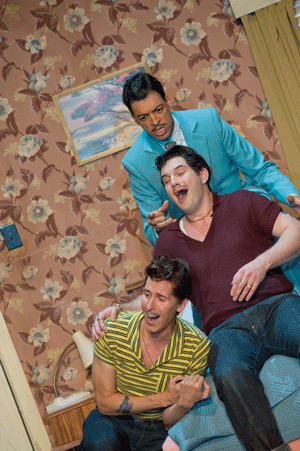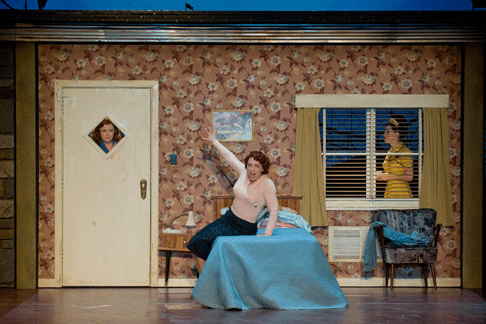All
goes well until a summer outing to the bustling resort of Budmouth-Regis. Amid
the sand and sea, the couples are inclined to re-align, and the ensuing erotic
entanglements have a melancholy outcome: the pleasure-seeking pair sail to
their deaths, while the remaining couple marry and, as the narrator pointedly
remarks, ‘fulfil their destiny according to Nature’s plan’.
In Phelim McDermott’s new production of CosÏ fan
tutte,there are similar ironic reversals on the boardwalk of
1950s Coney Island. But, while there is much entertainment on the esplanade,
there is little of Mozart’s ambiguous operatic psychology, or of Hardy’s
cynicism, in McDermott’s light-hearted seaside farce.
Nattily uniformed naval officers Ferrando and Guglielmo are on shore leave,
enjoying the fun of the fair with giggly sisters, Dorabella and Fiordiligi.
Over a night cap in the nightclub, they are challenged by sleazy magician, Don
Alfonso, to prove the loyalty of their beloveds. So, after a tearful farewell
and re-embarkment, they swap their lieutenants’ epaulettes for rockers’
leathers and return incognito to test the girls’ devotion and dependability.
 Randall Bills, Marcus Farnsworth and Roderick Williams
Randall Bills, Marcus Farnsworth and Roderick Williams
Predictably, heads and hearts are turned amid the hedonistic pursuits of the
pleasure garden. These are convincingly and enchantingly displayed by McDermott
and his designer, Tom Pye, whose attention to detail is impressive. The
flashing neon-sign of the aptly named Skyline Motel is framed by a
vista of distractions and diversions: the gentle gyrations of the ferris wheel,
the heady heights of the wooden rollercoaster, the whizzing slides of the
helter-skelter. Nostalgically painted in innocent primary colours, the scene is
depicted with tender irony: seagulls on sticks twirl around the esplanade
lampposts, stiff flags ‘flutter’ in the breeze.
The low-rise, post-war motel is itself neatly designed. Three rooms, whose
doors face an interior corridor, spin and rotate to allow the lovelorn ladies
to flounce from bedroom to bedroom, their histrionics espied by the maid
Despina — sparkling in a canary-yellow dress to match the Marigolds —
through the Venetian blinds. However, with the appearance of the overly ardent
‘greasers’ the spinning through the connecting doors becomes something of a
‘Carry On’.
In his magical fairground, strikingly tinted by Paule Constable’s gleaming
red, green and blue beams of colour, spiv Don Alfonso promises to fulfil any
desire — however daring and dangerous. Banners proclaim the pleasures on
offer, from Sweet Marie, to Louis the Undead and Kora the Depraved. Fantasies
are fashioned and indulged. Lovers float dreamily in oversize swans, framed
within red light-bulb hearts. There is much passion but little sincerity: in
the final scene, Don Alfonso’s trunk of tricks is expediently transformed for
matrimonial purpose by a speedily supplied altar-cloth.
It’s all very entertaining, but the profundity of Mozart’s psychological
comedy remains unexplored: laughter and sympathy, comedy and tragedy should be
held in perfect, ambivalent balance. Here, there is unalleviated light, but
little shade. Expect, that is, when Don Alfonso’s deception is finally
revealed, and anarchy breaks loose: partners are swapped at random, and the
quartet pair up briefly with assorted freaks and mutants, before equilibrium is
restored. McDermott seems, like Hardy’s cool narrator, to suggest that
surface differences are superficial and there is no natural ‘order’ or
destiny at all.
In fact it is the panoply of circus freaks which provides the thread which
hold the fantasy together. As the overture commences, before a shimmering gold
lamÈ curtain swathed in Constable’s gleaming light, master-of-ceremonies Don
Alfonso accompanied by his showgirl assistant, Despina, wheel out a chest of
curiosities from which climb — and somersault — a cast of eccentricities
and oddities: short and tall, strong man and sword-swallower, bearded lady and
fire-eater. The placards they bear announce the attractions of the vaudeville
to come. The curtain-raising trailer promises ‘Lust’, ‘Power’,
‘Entertainment’, ‘Politics’, ‘Big Arias’ and ‘Chocolate’ among
other titillating delights; and the billboards are re-arranged into various
applause-raising permutations — an amusingly wry device but sadly, on this
occasion, the arising laughter and ovation obliterated much of the overture.
As the show rolls on, this troupe of peculiars play their part in
Alfonso’s plotting: as bunny girls dishing up cocktails in the casino — as
strong men heaving props on and off, as spinners of Dr Magnetico’s
fantastical, life-restoring, firework-erupting contraption; or as circus
side-kicks levering Fiordiligi’s hot air balloon aloft. Throughout they
contribute to the carnivalesque and ensure slick stage business and nifty
transitions between scenes.
 Kate Valentine, Christine Rice and Mary Bevan
Kate Valentine, Christine Rice and Mary Bevan
And so to the cast. Kate Valentine’s self-satisfied Fiordiligi and
Christine Rice’s more self-knowing Dorabella are well-matched. Valentine
displayed much bombast in ‘Come scoglio’, coping with the peaks and
plummets, and showing the unappealing side of Fiordiligi’s pride in a haughty
lower register. In her second aria, the mock majesty was replaced by real
emotion; Valentine showed that she can truly act with her voice in a fluent,
intense, and thoughtfully phrased ‘Per piet‡’ Unfortunately, any genuine
pathos that the soprano evoked was destroyed by the staging. Fiordiligi must
yield to her desires while struggling to resist; there is real emotional
turmoil here, as she is deeply troubled by the fragility of her fidelity. But,
her inner conflict was rather bathetically rendered by the rise and fall of a
hot air balloon.
Mezzo-soprano Rice demonstrated a rich, creamy tone, and a sharp facility
for comic nuance —mimicking her sister’s indignation but eventually getting
fed up with her fickleness. Rice communicated directly, both musically and
theatrically, and the over-blown torment and solipsism of ‘Smanie
implacabili’ won both affection and gentle mockery.
Young British baritone Marcus Farnsworth was excellent as Guglielmo; he
fitted comfortably into the role, and like Rice balanced comedy with
psychological perception. The manly attributes professed in ‘Non siate
ritrosi’ may have raised a doubtful eyebrow, but the tone was unfailingly
warm and the phrases well-shaped, so it was no surprise that Guglielmo’s
attempt to win Dorabella’s heart was ultimately successful. Their ensuing
duet ‘Il core vi dono’ was seductively sweet, so that we might forget the
rapidity with which devotions had been reassigned.
Making his UK and ENO debut as Ferrando, American tenor Randall Bills was
somewhat disappointing; tense and taut in ‘Un’aura amorosa’, particularly
at the top, and generally sounding strained. Perhaps it was first-night nerves
but Bills seems to lack the Mozartean relaxation required to make us sympathise
with the scheming would-be seducer: Ferrando is genuinely hurt to learn that
Dorabella’s have given away the medallion with his portrait so quickly to her
new paramour, but Bills’ tight edginess and lack of gradation and colour was
uninviting.
Roderick Williams’ light baritone was characteristically pleasing, but not
sufficiently weighty to suggest Don Alfonso’s world-weary cynicism or the
force of character that could bait, goad and manoeuvre all those around him.
Despite his spangly red tuxedo, this Alfonso was surprisingly low-key. In
contrast, Mary Bevan’s Despina — whether bee-hived chalet-maid, or
be-wigged mesmeriser — had more commanding stage presence. One felt that it
was Despina who was the real maestro of manipulation: she accepted the
magician’s bouquet, but his snatched kiss earned him a slap. Light and bright
of voice, Bevan slipped convincingly into any costume, and any accent,
delivering the text with clarity and perky projection.
There were so many on-stage shenanigans — and much accompanying noise and
spontaneous audience appreciation — that at times it was easy to overlook
what was going on in the pit. ENO composer-in-residence Ryan Wigglesworth led
the ENO orchestra in a somewhat lacklustre performance, the tempi often in
disagreement with the stage, and the ensembles rather ragged. Wigglesworth also
played the fortepiano piano recitatives, which moved swiftly and fluently
onwards.
After his successes with Philip Glass’s Satyagraha and The
Perfect American, here McDermott once again demonstrates that he can put
on an entertaining show, serving up a visual and theatrical treat. It certainly
didn’t matter that a technical hitch rendered surtitles unavailable, as the
cast’s enunciation was uniformly crisp, making Jeremy Sams’ translation
clearly audible.
McDermott makes the slide from realism to fantasy utterly convincing;
everyone and everything is in a spin, as the tea-cup dodgems suggest. This is
certainly a show which will delight the punters, if not the purists.
Claire Seymour
Cast and production information:
Fiordiligi, Kate Valentine; Dorabella, Christine Rice; Ferrando,
Randall Bills; Guglielmo, Marcus Farnsworth; Don Alfonso, Roderick Williams;
Despina, Mary Bevan; Conductor, Ryan Wigglesworth; Director, Phelim McDermott;
Set Designer, Tom Pye; Costume Designer, Laura Hopkins; Lighting Designer,
Paule Constable; Orchestra of English National Opera. English National Opera,
Coliseum, London, Friday 16th May 2014.
image=http://www.operatoday.com/6377.gif
image_description=Kate Valentine, Randall Bills, Marcus Farnsworth, Christine Rice, Sally Reeve [Photo by Mike Hoban]
product=yes
product_title=CosÏ fan tutte at ENO
product_by=A review by Claire Seymour
product_id=Above: Kate Valentine, Randall Bills, Marcus Farnsworth, Christine Rice, Sally Reeve
Photos by Mike Hoban